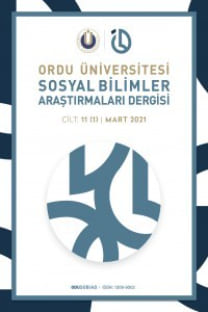Roma Sanatında Sonsuz Zaman: Aion Kişileştirmesi
Antik Yunan inanışında zaman kavramı = Aion; yaşam süresini ve sonsuz yaşamı ifade etmek için kullanılan bir
terimdir. Zaman kavramı içerisinde de insan ömrünün süresinin ve dahi her şeyin başlangıcından önceki zamanı
ve sonsuzluğu ifade eden bu kavramın Geç Hellenistik döneme kadar herhangi bir sanat türünde tasvirine
rastlanmaz. Mısır ve Pers inancının etkisinde Yunan sanatına senkrentik bir tanrı olarak yansımıştır. Bu
dönemden sonra, aslan başlı, omuzlarında kanatları olan insan vücutlu bir yaratık olarak tasvir edilmeye
başlamıştır. Genellikle yanında ya da vücuduna dolanmış bir yılan ile ellerinde asa ve anahtar tutmaktadır. Bu
tasvirleri kesin bir şekilde Aion olarak değerlendirmek tartışma konusu olmuştur. Ancak kesin olarak Aion
olduğunu belirtebileceğimiz tasvirlere Roma İmparatorluk Dönemi’nde rastlamaktayız. Neredeyse bütün
betimlerde gür ve kır saçlı, yaşlı veya genç, genellikle bir elinde zodyak çemberi ve ayrıca küre, papirüs rulosu ve
bereket boynuzu tutan bir erkek figürü olarak kişileştirilmiştir. Bu dönem sanatında karşımıza çıkan Aion
kişileştirmesi, İmparatorluğun sonsuzluğunun ve ebedi olduğunun propagandasını yapmak için kullanılmıştır.
Anahtar Kelimeler:
Roma, Sanat, Sonsuz Zaman, Aion, Kişileştirme
Endless Time In Roman Art: Aion Personalization
The concept of time in ancient Greek belief, Aion, is a term used to express life span and eternal life. Within the
concept of time, this concept, which expresses the duration of human life and the time and eternity before the
beginning of everything, is not depicted in any kind of art until the Late Hellenistic period. Influenced by
Egyptian and Persian beliefs, he was reflected in Greek art as a syncretic god. After this period, he began to be
depicted as a human-shaped creature with the head of a lion and wings on his shoulders. He usually holds a
scepter and a key in his hands with a snake entwined with him or his body. It has been a matter of debate to
definitely consider these depictions as Aion. However, we come across depictions that we can define as Aion in
the Roman Imperial Period. In almost all depictions, he is personified as a male figure with bushy and gray
hair, old or young, usually holding the zodiac circle in one hand, as well as a globe, papyrus roll, and horn of
fertility. The personification of Aion, which appeared in the art of this period, was used to propagate the
eternity of the Empire.
Keywords:
Roman, Art, Infinite Time, Aion, Personification,
___
- Akalın, K. H. (2009). Mitra Efsanelerinin ve Mucizelerinin Hristiyanlık Üzerindeki Etkileri, Akademik Bakış, 17, 1-17.
- Alföldi, A. (1979). Aion in Mérida und Aphrodisias, Mainz am Rhein.
- Birowsky, G. (2007). AION: A Cosmic Allegory on a Coin from Tyre?, Israel Antiquities Authoriy.
- Can, B. (2014). Antik Çağ Mozaiklerinde Sembolizm ve Kişileştirme (Personification), Aktüel Arkeoloji, 39, 44-49.
- Cohen, S. (2014). Transformations of Time and Temporality in Medievel and Renaissance Art, s.14-15.
- Cumont, F. V. M. (1960). Astrology and Religion Among the Greeks and Romans, New York: Evinity Publishing.
- Dunbabin, K. M. D. (1999). Mosaics of the Greek and Roman World, Cambridge University.
- Gurshtein, A. A. (1997). The Origins of the Constellations: Some Provocative Hypotheses Link the Origins of the Constellations to the Precession of the Earth's Axis and the Symbolic Imagery of Ancient Peoples, American Scientist, 85 (3), 264–273. JSTOR, www.jstor.org/stable/27856779. Accessed 10 Dec. 2020.
- Homeros. (2014). İlyada, (Çev. Demir, M.), Ankara.
- http-1. (2022). Dionysiaca, https://www.theoi.com/Text/NonnusDionysiaca7.html, Erişim Tarihi: 17.05.2022.
- Karataş, İ. E. (2006). Max Müller: Hayatı, Eserleri ve Dinler Tarihindeki Yeri. (Yayımlanmamış Doktora Tezi), Dokuz Eylül Üniversitesi Sosyal Bilimler Enstitüsü, İzmir.
- Kleiner, D. E. E. (1992). Roman Sculpture, New Haven and London.
- Müller, M. (1882). Friedrich, İntroduction to the Science of Religion, London.
- Platon (Eflatun), (2001). Devlet, (Çev. Eyüboğlu, S. ve Cimboz, M. A.) Türkiye İş Bankası Kültür Yayınları, İstanbul.
- Sezer, S. S. (2015). Nıkomedıa Antik Kenti’nden Heykeltıraşlık Eserleri, Pamukkale Üniversitesi Sosyal Bilimler Enstitüsü Dergisi, 20, 78-99.
- Smith, R.R.R. (1993). The Monument of Julius Zoilos, Mainz am Rhein, New York University.
- Tekçam, T. (2007). Arkeoloji Sözlüğü. İstanbul: Alfa Yayınları.
- Vermaseren, M. J. (1963), Mithras: The Secret God, London: Chatto & Windus.
- ISSN: 1309-9302
- Yayın Aralığı: Yılda 3 Sayı
- Başlangıç: 2010
- Yayıncı: -
Sayıdaki Diğer Makaleler
Miray BEŞBUDAK, Neslihan ÖZMELEK TAŞ, Azra K. NAZLI
Gösterişçi Tüketim Davranışı Ekseninde Yeni Orta Sınıfların Tüketim Pratikleri
Câhiliye Dönemi’nde Siyasetin Edebiyata Etkisi
Türkiye’de Cumhuriyet Sonrası Çıkan Çocuk Dergi Kapak Tasarımlarının Görsel Analizi
Unamuno ve “Çağdaş Hıristiyanlık”
Neapolis Nekropolü’nden Cam Eserler
Zerrin AYDIN TAVUKÇU, Ayşe AVLİ
